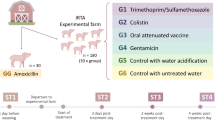Abstract
We present herein the composition of bacterial communities occurring in ground chicken and the changes which arise in these populations based upon nonselective partitioning by commercially-available Dynal anti-Salmonella and anti-E. coli O157 immunomagnetic beads (IMB). Our enumeration and colony selection protocol was based upon a 6 × 6 drop plate method (n = 18 for each 25-g sub-sampling) using a dilution which resulted in ca. 4–8 colonies per drop. An average of 82 ± 13 colonies were selected from three 25-g ground chicken subsamplings per batch, each of which was repeated seasonally for one year. DNA was extracted from each colony and the composition of Eubacteria in each of these harvests was determined by sequence-based identification of 16S rDNA amplicons. The Gram-positive bacteria Brochothrix thermosphacta and Carnobacterium maltaromticum were the most commonly found organisms in both the total chicken wash (PBS) and in the IMB-bound (PBS-washed) fractions. The remaining background organisms which also adhered to varying degrees to commercial IMBs were: Pseudomonas oleovorans, Acinetobacter lwoffi, Serratia spp., and one Rahnella spp. A large number of the organisms were also cladistically evaluated based on rDNA basepair disparities: all Brochothrices were monophyletic; twelve different Pseudomonads were found along with eight Carnobacteria, seven Acinetobacteres, four Serratiae, and two Rahnellae. Carnobacterium alone showed an IMB-based concentration enhancement (ca. two to sixfold).



Similar content being viewed by others
References
Guesdon JL, Avrameas S (1977) Immunochemistry 14:443–447
Haukanes B-I, Kvam C (1993) Bio/technology 11:60–63
Uhlen M (1989) Nature 340:733–734
Irwin P, Fortis L, Chau L, Tu S-I (2003) J Rapid Methods Autom Microbiol 10:263–279
Irwin P, Gehring A, Tu S-I, Brewster J, Fanelli J, Ehrenfeld E (2000) J AOAC Int 83:1087–1095
Solé S, Merkoçi A, Alegret S (2001) Trends Anal Chem 20:102–110
D’Aoust JY, Maishment C (1979) J Food Prot 42:153–157
Tu S-I, Patterson D, Uknalis J, Irwin P (2000) Food Res Int 33:375–380
Tu S-I, Golden M, Andreotti P, Yu LSL, Irwin P (2001) J Rapid Methods Autom Microbiol 9:71–84
Cudjoe KS, Krona R, Olsen E (1994) Int J Food Microbiol 23:159–165
Gottschalk M, Lacouture S, Odierno L (1999) J Clin Microbiol 37:2877–2881
Crawford CG, Wijey C, Fratamico P, Tu S-I, Brewster J (2000) J Rapid Methods Autom Microbiol 8:249–264
Irwin P, Gehring A, Tu S-T, Chen C-Y (2004) Carbohydr Res 339:613–621
Marshall KC, Stout R, Mitchell R (1971) J Gen Microbiol 68:337–348
Otto K, Elwing H, Hermansson M (1999) J Bacteriol 181:5210–5218
Gilbert P, Evans DJ, Evans E, Duguld IG, Brown MRW (1991) J App Bacteriol 71:72–77
Medina MB (2001) Int J Food Microbiol 69:199–208
Ripabelli G, Sammarco ML, Grasso GM (1999) J Food Prot 62:198–201
Irwin P, Damert W, Brewster J, Gehring A, Tu S-I (2002) J Rapid Methods Autom Microbiol 10:129–147
Tu S-I, Uknalis J, Gore M, Irwin P, Feder I (2003) J Rapid Methods Autom Microbiol 11:35–46
Irwin P, Damert W, Tu S-I (2004) J Rapid Methods Autom Microbiol 11:265–284
Batteiger B, Newhall WJ, Jones RB (1982) J Immunol Methods 55:297–307
Spinola SM, Cannon JG (1985) J Immunol Methods 81:161–165
Haycock JW (1993) Anal Biochem 208:397–399
Shmanai VV (1999) J Immunoassay 20:13–30
Sakaki S, Iwasaki Y, Nakabayashi N, Ishihara K (2000) Polym J 32:637–641
Michalewski MP, Kaczmarski W, Golabek A, Kida E, Kaczmarski A, Wisniewski KE (1999) Anal Biochem 276:254–257
Gehring AG, Crawford CG, Mazenko RS, Van Houten LJ, Brewster JD (1996) J Immunol Methods 195:15–25
Aguilera A, Gonzalez-Gil S, Keafer BA, Anderson DM (1996) Mar Ecol Prog Ser 143:255–269
Granot E (1994) J Clin Lab Immunol 43:183–186
Irwin P, Fortis L, Tu S (2001) J Rapid Methods Autom Microbiol 9:33–51
Chen C, Nace G, Irwin P (2003) J Microbiol Methods 55:475–479
Irwin PL, Nguyen L-HT, Chen C-Y (2007) accompanying manuscript: Binding of nontarget microorganisms from food washes to anti-Salmonella and anti-E. coli O157 immunomagnetic beads: minimizing the errors of random sampling in extreme dilute systems
de Levie R (2004) Advanced excel for scientific data analysis. Oxford University Press, Oxford, UK, 615 pp
Cottrell E, Kirchman D (2000) Appl Environ Microbiol 66:5116–5122
Thompson J, Higgins D, Gibson T (1994) Nucl Acids Res 22:4673–4680
Tamplin M (2002) J Food Prot 65:1535–1540
Holt J, Krieg N, Sneath P, Staley J, Williams S (1994) Bergey’s manual of determinative bacteriology, 9th edn. Williams and Wilkins, Baltimore, 787 pp
Prest A, Hammond J, Stewart G (1994) Appl Environ Microbiol 60:1635–1640
Farmer J III, Fanning G, Huntley-Carter G, Holmes B, Hickman F, Richard C, Brenner D (1981) J Clin Microbiol 13:919–933
Piette J, Idziak E (1991) Biofouling 5:3–20
Author information
Authors and Affiliations
Corresponding author
Additional information
Any reference to a brand or firm name does not constitute endorsement of the US Department of Agriculture over others of a similar nature not mentioned
Rights and permissions
About this article
Cite this article
Irwin, P., Nguyen, LH., Chen, CY. et al. Binding of nontarget microorganisms from food washes to anti-Salmonella and anti-E. coli O157 immunomagnetic beads: most probable composition of background Eubacteria. Anal Bioanal Chem 391, 525–536 (2008). https://doi.org/10.1007/s00216-008-1959-2
Received:
Revised:
Accepted:
Published:
Issue Date:
DOI: https://doi.org/10.1007/s00216-008-1959-2




